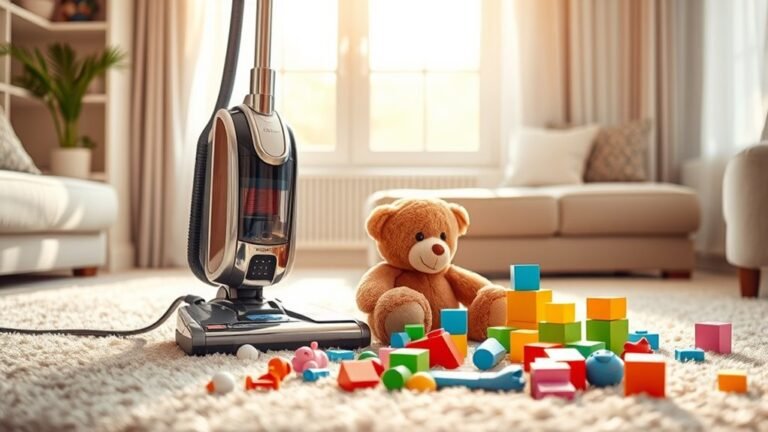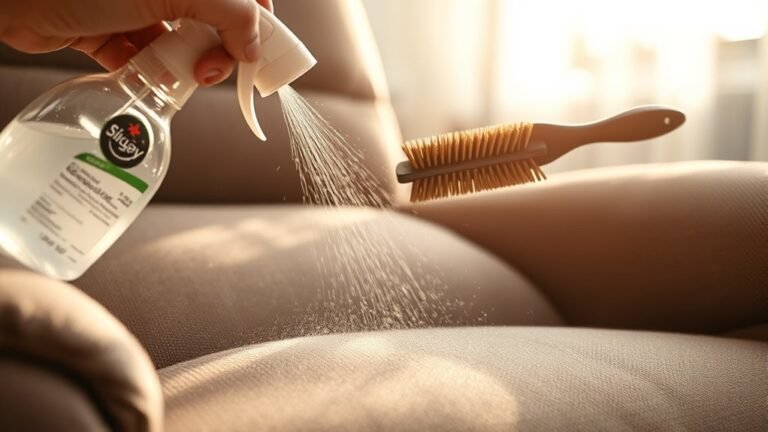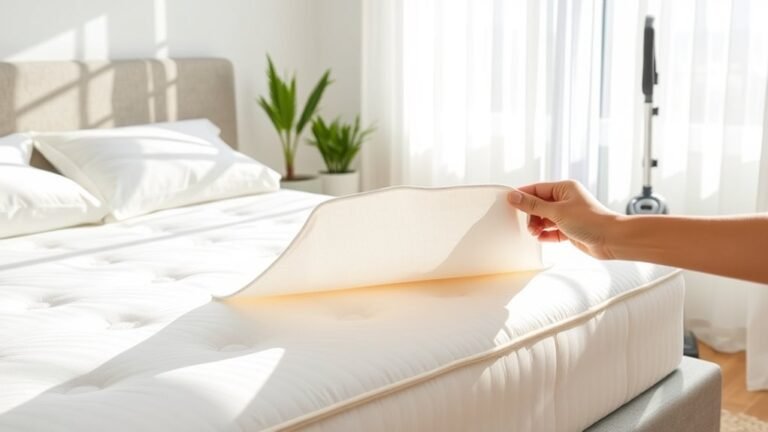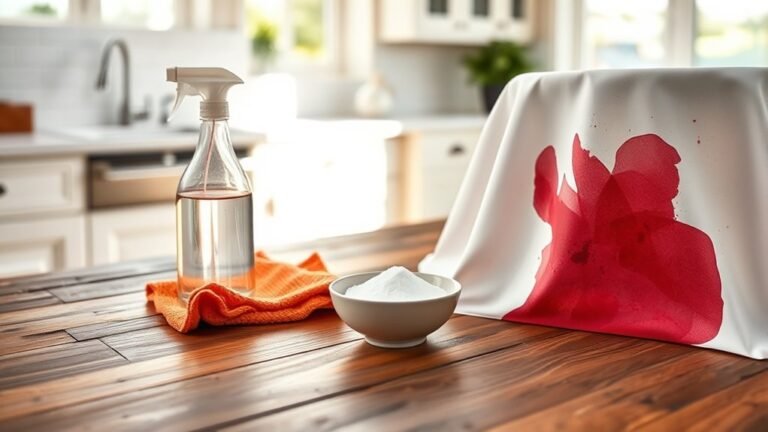Cleaning Mistakes That Damage Your Chair
You’re damaging your chair when you use harsh chemicals or ignore the manufacturer’s cleaning instructions, which can harm fabrics or leather. Over-wetting upholstery invites mold and stains, while scrubbing too hard wears down fibers. Using the wrong tools or leaving cleaning residue also leads to deterioration. Neglecting regular dusting weakens the fabric over time. If you want to keep your chair looking great longer, understanding the right care details makes all the difference.
Using Harsh Chemicals on Fabric or Leather
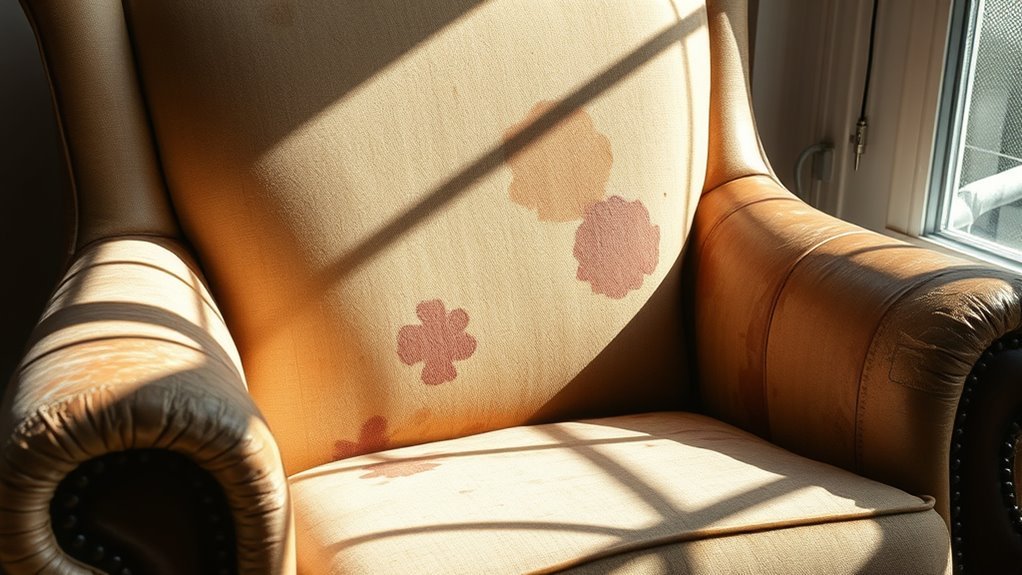
Although it might seem like a quick fix, using harsh chemicals on fabric or leather can actually damage your chair’s material. When you apply strong cleaners, you trigger chemical reactions that weaken the fibers or disrupt the leather’s protective finish. This leads to fabric deterioration or cracks in leather, stripping away the freedom to enjoy your chair’s original comfort and look. Instead of risking irreversible damage, opt for gentle, fabric- or leather-specific cleaners. This way, you maintain your chair’s integrity without compromising its lifespan. Remember, your chair deserves care that respects its material, not shortcuts that cause harm. By avoiding harsh chemicals, you hold the power to preserve your chair’s beauty and durability, keeping it inviting and reliable for years to come.
Over-Wetting Upholstery During Cleaning
When you soak your chair’s upholstery too much, it can trap excess moisture deep inside. This makes drying tricky and may lead to mold or fabric damage. You’ll want to avoid over-wetting to keep your chair in good shape.
Excess Moisture Effects
If you soak your chair’s upholstery too much during cleaning, you risk causing serious damage. Excess moisture absorption weakens the fabric fibers and compromises upholstery integrity. When your chair takes on more water than it can handle, you might notice:
- Mold and mildew growth hidden beneath the surface
- Warping or shrinking of the padding and fabric
- Stains becoming more pronounced rather than fading
- Unpleasant odors developing from trapped dampness
- Frame damage due to prolonged exposure to moisture
You want your chair to last and keep looking fresh, so controlling moisture is essential. Avoid drenching the fabric, and remember, less is often more when cleaning upholstery. Protect your freedom to enjoy your chair without worrying about hidden damage caused by over-wetting.
Fabric Drying Challenges
Since over-wetting your chair’s upholstery makes thorough drying difficult, you’ll often face issues like lingering dampness and musty smells. When fabric stays wet too long, it not only invites mold but also increases fabric shrinkage concerns, which can permanently alter your chair’s fit and feel. To avoid this, you need smart drying time strategies—think using fans, opening windows, or even portable heaters to speed up air circulation without risking heat damage. Don’t rush the process; patience guarantees your fabric dries evenly and stays in great shape. Remember, less water during cleaning means less drying stress. Keep your freedom to relax in a fresh, comfy chair by mastering these drying challenges and preventing costly, irreversible damage.
Ignoring Manufacturer’s Cleaning Instructions
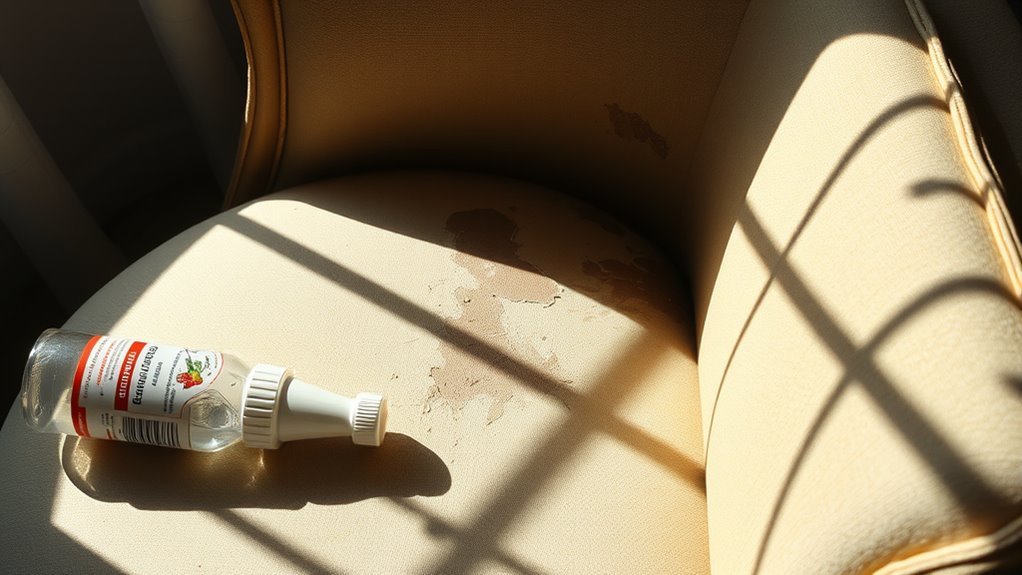
Although it might seem easier to use your favorite household cleaner, ignoring the manufacturer’s cleaning instructions can damage your chair’s fabric or finish. Manufacturer guidelines are designed to protect your chair’s materials and guarantee longevity. When you skip these, you risk discoloration, weakening fibers, or stripping finishes.
To keep your chair looking great while enjoying freedom in your cleaning routine, always:
- Follow recommended cleaning methods on the care label
- Use only approved cleaning products
- Test cleaners on an inconspicuous spot first
- Avoid mixing chemicals not suggested by the manufacturer
- Respect drying and maintenance advice
Scrubbing Too Vigorously and Damaging Fibers
Many people don’t realize that scrubbing your chair too hard can actually wear down its fibers and ruin the fabric’s texture. When you’re keen to get rid of stains or dirt, it’s tempting to apply heavy pressure, but this often leads to fiber damage. To keep your chair looking fresh, focus on gentle cleaning methods that respect fiber care. Use soft cloths or brushes and light circular motions instead of harsh scrubbing. This approach preserves the fabric’s integrity and extends its lifespan. Remember, taking it easy during cleaning doesn’t mean less effective—it means smarter care that lets your chair stay comfortable and vibrant. So, slow down, be gentle, and give your chair the fiber care it deserves.
Neglecting Regular Dusting and Vacuuming
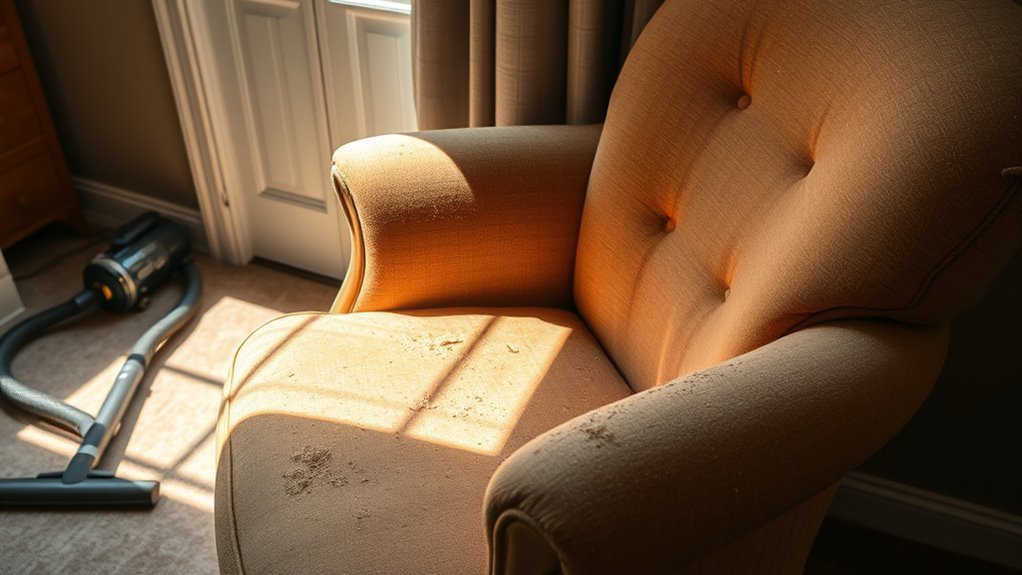
If you skip regular dusting and vacuuming, dust can build up and damage your chair’s fabric over time. It’s important to vacuum frequently to keep dirt from settling deep into the fibers. Using the right tools and techniques will help you remove dust effectively without harming your chair.
Dust Buildup Consequences
When you skip regular dusting and vacuuming, dust can quickly accumulate on your chair, leading to several problems. This buildup not only makes your chair look dirty but also invites dust mites, which thrive in neglected areas. If you suffer from a dust allergy, this can worsen your symptoms, reducing your comfort and freedom in your own space. Ignoring this can also:
- Cause fabric wear and discoloration
- Trap unpleasant odors
- Reduce the chair’s lifespan
- Attract more allergens and pests
- Make cleaning harder over time
Keeping your chair dust-free isn’t just about looks—it’s essential for your health and preserving your chair’s quality. Don’t let dust control your comfort or limit your freedom.
Vacuuming Frequency Importance
Neglecting regular dusting often leads to the need for more frequent vacuuming to keep your chair clean. When dust settles, it clings to upholstery fibers, making vacuuming more challenging. To maintain your chair’s freedom from dirt, adopting effective vacuuming techniques is essential. Skipping this step can cause dust and debris to embed deeper, accelerating wear. By committing to a consistent vacuuming schedule, you protect your upholstery’s integrity and extend its life. Think of vacuuming as a key part of your upholstery maintenance routine—not just a chore but a way to keep your chair fresh and inviting. Don’t wait until dirt’s obvious; regular care prevents buildup and saves you effort later. Freedom in your space starts with simple, smart habits like this.
Proper Dust Removal
Although it might seem minor, skipping regular dusting and vacuuming can quickly lead to a buildup that’s harder to remove and damages your chair’s fabric over time. You want to keep your chair looking fresh and last longer, so adopting effective dusting techniques is key. Using microfiber cloths helps trap dust without scratching delicate surfaces. Here’s how to properly remove dust:
- Dust your chair weekly to prevent buildup
- Use a vacuum with upholstery attachments for deep cleaning
- Wipe with a slightly damp microfiber cloth for stubborn dust
- Avoid harsh chemicals that degrade fabric over time
- Rotate cushions regularly to expose all areas for dusting
Applying Stain Removers Without Testing First
Before you apply any stain remover to your chair, you should always test it on a hidden spot first. Skipping stain remover tests can lead to unexpected damage, like discoloration or fabric weakening. Every fabric reacts differently, so checking fabric compatibility is essential to avoid ruining your chair’s look and feel. You want the freedom to clean confidently without worrying about harm. Take a moment to dab a small amount of the remover on an inconspicuous area and wait a few minutes. If the color stays true and the fabric holds up, it’s safe to proceed. This simple step protects your investment and keeps your chair looking fresh, giving you peace of mind as you tackle stubborn stains. Don’t risk it—test first.
Using the Wrong Cleaning Tools for the Material
If you grab the wrong cleaning tools, you could end up damaging your chair’s material instead of freshening it up. It’s essential to match your cleaning tools with material compatibility to keep your chair looking its best. Using abrasive brushes on delicate fabrics or harsh sponges on leather can cause scratches, tears, or discoloration.
To avoid this, consider these tips for choosing the right cleaning tools:
- Use soft microfiber cloths for smooth surfaces and delicate fabrics
- Opt for gentle brushes with soft bristles on textured materials
- Avoid steel wool or rough scrubbers on any upholstery
- Select sponges designed for your chair’s specific material
- Always check product labels for recommended cleaning tools
Leaving Cleaning Residue on Surfaces
Choosing the right cleaning tools is just one part of caring for your chair; you also need to be mindful of how cleaning products are removed afterward. If you don’t rinse or wipe away cleaning agents properly, residue buildup can occur on your chair’s surfaces. This leftover residue can attract dirt, cause discoloration, or even degrade the material over time. To avoid this, adopt cleaning techniques that include thorough rinsing with a damp cloth or using a clean, dry microfiber towel to remove any excess cleaner. Don’t rush this step—it’s vital for preserving your chair’s look and feel. By being diligent about removing cleaning products fully, you guarantee your chair stays fresh and free from unwanted buildup, giving you the freedom to enjoy it without worry.
Failing to Dry the Chair Properly After Cleaning
Even when you clean your chair thoroughly, failing to dry it properly can undo all your hard work. Moisture left behind invites mold, weakens materials, and leads to unpleasant odors. To maintain your chair’s freedom from damage, mastering drying techniques is crucial.
Here’s how you can guarantee effective moisture control:
- Use a clean, dry cloth to blot excess water immediately.
- Allow the chair to air dry in a well-ventilated space.
- Avoid direct sunlight, which can cause fading or warping.
- Consider a fan or dehumidifier to speed up drying.
- Don’t sit or use the chair until it’s completely dry.
Frequently Asked Questions
How Often Should I Deep Clean My Chair?
You should set your deep cleaning frequency by your chair’s use, environment, and material. For everyday use, aim for deep cleaning every 3 to 6 months. For lighter use, every 6 to 12 months works fine. Remember, consistent chair maintenance tips include vacuuming regularly, treating stains promptly, and rotating cushions if possible. Taking these steps helps you enjoy your chair longer, keeping it fresh, comfortable, and ready for whatever freedom your day brings.
Can Sunlight Damage My Chair’S Fabric or Leather?
Yes, sunlight exposure can definitely damage your chair’s fabric or leather. Over time, the UV rays cause fabric fading and can weaken the material, making it brittle or cracked. To keep your chair looking fresh and free, it’s best to avoid prolonged sun exposure by placing it away from direct sunlight or using curtains. This way, you maintain your freedom to enjoy your space without worrying about damage.
What’S the Best Way to Remove Pet Hair From Upholstery?
When it comes to pet hair removal, you’ll want to keep it simple and effective. Start by using a vacuum with an upholstery attachment to lift hair without damaging fabric. For stubborn hair, try a rubber glove or a damp sponge—they grab hair effortlessly. Regular upholstery cleaning helps prevent buildup, making your space feel fresher and freer. You’ll enjoy your furniture more when it’s clean and hair-free, letting you relax without worries.
Are Professional Cleaning Services Worth the Cost?
When you’re weighing if professional cleaning services are worth it, consider a cost comparison with DIY efforts. Sometimes, spending a bit more saves you time and protects your furniture better. Check service reviews to find reliable pros who deliver quality results without hidden fees. Choosing experts can free you from the hassle, letting you enjoy your space without stress. It’s about balancing your budget and your freedom to relax.
How Can I Protect My Chair From Future Stains?
You don’t want stains attacking your chair like a wild beast, right? To keep your freedom from constant worry, consider applying stain resistant fabric treatments. These treatments act like an invisible shield, repelling spills and grime before they settle in. Regularly clean your chair gently and avoid harsh chemicals, so the fabric stays intact. With these steps, you’ll enjoy your chair’s beauty and comfort without sacrificing your carefree lifestyle.

